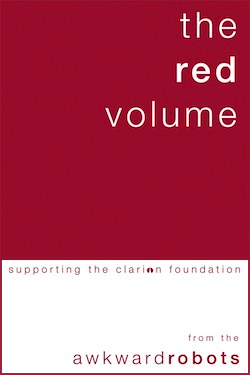Earlier this week, Clarion class of 2012 (the self-proclaimed Awkward Robots) released a pay what you can anthology to support the work of the Clarion Foundation, the non-profit parent group to the Clarion Science Fiction and Fantasy Writers’ Workshop.
Clarion has a long career of turning out the newest generations of vibrant and talented SFF writers, including the likes of Octavia Butler and Cory Doctorow. The Awkward Robots are no exception. If Clarion’s illustrious alumni and educational MO haven’t convinced you to throw a few dollars (or more) at The Red Volume, the stories from these up-and-coming writers should certainly do the trick.
The Red Volume is as diverse as the genres it supports. Fantasy, scifi, horror—anything from ghosts to aliens to shapeshifters—line its pages. A few motifs do recur to connect one story to the next: the color red, for instance—whether goddess-blessed red shoes or virus-eaten tomato plants—splashes across a number of them. Explorations of queer and familial (and queer familial) relationships abound. Many of the stories touch on the idea of home, both structural and emotional, and all of the grief and malevolent spirits that come attached. These recurrences certainly don’t define every story, though; instead, they provide a steady, comfortably paced path through the anthology.
Another thematic thread throughout The Red Volume is the importance of storytelling. Lisa Bolekaja’s “Don’t Dig Too Deep” and Chris Kammerud’s “The Monster That Sings” are two quite different, quite amazing variations on the theme, the former telling the story of a young girl whose neighbor’s tall tales come true, and the latter of a show tune-singing ghost. Perhaps my favorite of the lot, though, was “Titian,” by Danica Cummins. Told through varying confessional vignettes and excerpts from the untold archives of girl detective Nancy Drew, “Titian” is about a young man named Theodore grappling with a world that denies the existence of the voice he trusts the most. Unlike so many stories where the protagonist questions the truth of his reality, Theodore’s tale is more concerned with why a certain person is allowed to exist in one world and not another. It reminded me of Caitlin Kiernan’s Drowning Girl in the best possible way, down to its creeping uncertainty and ambiguous exploration of gender.

“Bought in Blood” by Ruby Katigbak is another of the Anthology’s stand-out stories, this one about a World War I foot soldier caught in the crossfire of both human and supernatural warfare. When James sees a redcap wandering the body-lined trenches of France, he doesn’t run: he makes a deal. For every man he brings to the brink of death, he is allowed to taste a portion of the redcap’s meal. While his fellow soldiers grow weak, James buoys with strength. While their minds break under the fall of shells, he is resilient, becoming hungrier and hungrier for his next kill. As with so many good war stories, the lynch pin in “Bought in Blood” is the relationship between the soldiers, the intense and tenuous links forged in a life defined by death. This story is dark and violent, and yet unlike any war story I’ve read in recent memory.
A number of other pieces in The Red Volume struck a cord with me—too many to do justice here. Sam J. Miller’s “Haunting Your House” combines ghosts, sex, and gentrification in a story as dark as it is satisfying. Still stranger, in Luke R. Pebler’s “Awesome Story Great Job,” the future world revolution hinges on hidden messages encoded in episodes of Tim & Eric Awesome Show. Needless to say, if you’re looking for fresh, diverse SFF, The Red Volume is a great place to start. It samples a full gamut of worlds and themes, and keeps you on your toes for each and every one. If one story fails to pique your interest, the next will likely inhabit a whole other category, and may even be your favorite of the lot.
What’s more, your support of the volume will actively help to produce more quality work just like (or unlike) it. Consider checking the anthology out here.
Emily Nordling is a writer and reader living in Chicago, IL. She thrives primarily on tea, books, and social justice.










